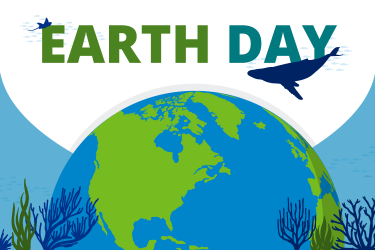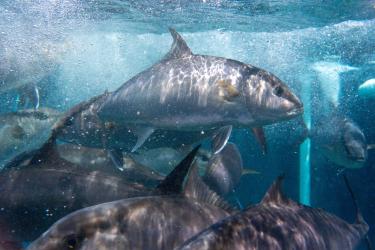Marine mammals and their health are intrinsically linked to the marine environment, and to the people who live near the coast or share the same food. Marine mammals are important indicators of ocean health. They provide insight into disease and larger human-caused and environmental issues that may be impacting our oceans. When a sick, injured, or dead marine mammal washes ashore or is found floating at sea, NOAA Fisheries and our partners strive to respond to the case and determine the cause. Marine mammals strand for a variety of reasons. However, marine diseases and die-offs can have impacts that alter marine mammal populations and cause major changes in marine communities. When multiple sick, entangled, injured, or dead individual animals are discovered within a short timeframe and in the same geographic area, it can indicate a larger situation. There are possible consequences for human health.
Unusual Mortality Events
An Unusual Mortality Event is defined in the Marine Mammal Protection Act as “a stranding that is unexpected; involves a significant die-off of any marine mammal population; and demands immediate response.” How can we tell if a group of marine mammal strandings can be considered a UME? The Working Group on Marine Mammal Unusual Mortality Events is a scientific panel of experts who are tasked with reviewing events using seven criteria. Their expert recommendation provides guidance to NOAA Fisheries about whether a marine mammal mortality event should be deemed “unusual.”
Working Group on Marine Mammal Unusual Mortality Events
Following a large number of marine mammal mortalities in the late 1980s, the Working Group was established in 1991. It was formalized by Congress through 1992 amendments to the Marine Mammal Protection Act (MMPA). The Working Group is responsible for investigating possible UME situations and providing a recommendation to NOAA Fisheries or the U.S. Fish and Wildlife Service for formally declaring a UME. Both agencies protect marine mammal species under their jurisdiction:
- NOAA Fisheries is responsible for all cetaceans (whales, dolphins, and porpoises) and most pinnipeds (seals and sea lions)
- U.S. Fish and Wildlife Service is responsible for sea otters, walruses, polar bears, and manatees
After a UME is declared, financial support from the UME Fund may be available to help the response of local stranding network partners and the investigation into the cause(s) of the event.
To date, more than 70 UMEs have been officially declared since 1991. Each UME is unique in terms of the species involved, geographic location, and response capacity. The cause of a UME can include:
- Infectious diseases such as viruses or bacteria
- Human interactions including entanglements and vessel strikes
- Biotoxins
- Malnutrition
- Ecological factors such as prey shifts or fresh water exposure
In some cases, the underlying cause of the UME is not determined. Better understanding UMEs can lead to an improved understanding of the health of ocean ecosystems and marine mammal populations.
Working Group Members
The UME Working Group currently includes 12 voting members. They have knowledge and experience in marine science, marine mammal science, veterinary and husbandry practices, marine conservation, and medical science. These experts come from a wide range of professions from scientific, academic, and government institutions, to conservation organizations. Individuals are chosen to balance the knowledge and expertise of the group across the various disciplines required by the MMPA. Members are selected to serve 3-year terms which can be renewed once, with the group membership rotating periodically. There are also non-voting members with marine mammal, ocean, or wildlife health expertise. They represent additional federal agencies and neighboring countries (Canada and Mexico) who offer additional expertise to the Working Group.
The current voting members of the UME Working Group are:
- Andrew Garrett, Florida Fish and Wildlife Conservation Commission
- Tracey Goldstein, Ph.D., Working Group Chair, One Health Institute, Colorado State University
- Craig Harms, D.V.M., Ph.D., A.C.Z.M., Working Group Chair-Elect, North Carolina State University
- James Harvey, Ph.D., San Jose State University (retired)
- Michelle Lander, Ph.D., NOAA Fisheries
- Kathi Lefebvre, Ph.D., NOAA Fisheries
- Kathleen Moore, M.E.M., International Fund for Animal Welfare
- Sinead Morris, Ph.D., Centers for Disease Control and Prevention
- Stephen Raverty, D.V.M., Ph.D., Dipl. A.C.V.P., British Columbia Ministry of Agriculture
- Sarah Sharp, D.V.M., International Fund for Animal Welfare
- Cynthia Smith, D.V.M., National Marine Mammal Foundation
- Len Thomas, Ph.D., University of St. Andrews
Responsibilities of the Working Group
NOAA Fisheries Marine Mammal Health and Stranding Response Program coordinates the UME Working Group and updates the members on potential or ongoing UME cases. To begin the process of determining whether or not a UME is occurring, the Program provides a consultation package including historical and current stranding data and other available information to the Working Group. They use this information to assess and determine within 48 hours if the situation meets one of seven UME criteria. The Marine Mammal Health and Stranding Response Program then forwards the Working Group’s recommendation to NOAA’s Assistant Administrator for Fisheries for review. If NOAA Fisheries or U.S. Fish and Wildlife Service agrees with the Working Group’s recommendation, then the appropriate trust agency declares a UME for the marine mammal species. In 1996, NOAA Fisheries and our partners developed a National Contingency Plan to identify foundational actions needed for UME response and investigation.
The Working Group is also responsible for recommending how federal funds in the UME Fund should be spent to support UME responses and investigations. For example, the UME Fund has been used to support the costs of gathering tissue samples, caring for live stranded animals, and collecting data to improve future UME investigations. Under the MMPA, Congress gave the Marine Mammal Health and Stranding Response Program special authority to accept private donations or bequests to keep the Fund financially sound.
Support Marine Mammal Response
You can help marine mammals and UME response. By supporting the UME Fund, you can help cover some of the costs incurred by the Marine Mammal Stranding Network while investigating UMEs.




